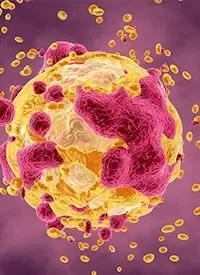Article
PROMIS Scores Provide Insight Into PROs With Radiation Therapy in Soft Tissue Sarcoma
Author(s):
Patient Reported Outcomes Measurement Information System scoring indicated that preoperative and postoperative radiation therapy was associated with worse anxiety and physical function in patients with soft tissue sarcoma who had resulting wound complications compared with those who did not.

Patient Reported Outcomes Measurement Information System (PROMIS) scoring indicated that preoperative and postoperative radiation therapy was associated with worse anxiety and physical function in patients with soft tissue sarcoma who had resulting wound complications compared with those who did not, according to findings from a study that was published in Clinical and Translational Radiation Oncology.1
The results showed that patients with wound complications were more likely to have a significant increase in anxiety (36.4% vs 8.3%; P = .020) and a significant decrease in physical function (57.1% vs 16.2%; P = .011) independent of the timing of radiation therapy.
“This study demonstrates minimum significant change thresholds to detect PROMIS changes in soft tissue sarcoma patients undergoing pre- and postoperative radiotherapy. As expected, more patients with preoperative radiation therapy than postoperative radiation therapy had wound complications, but patients with complications in both groups had worse anxiety and function at the completion of treatment compared with those that did not,” wrote lead study author T.M. Moon, MD, of Washington University in St. Louis, and coauthors, in the study publication.
Wide surgical excision and radiation therapy is the recommended local treatment for patients with high-risk soft tissue sarcoma of the extremities. However, the determination of whether to give radiation therapy pre- or postoperatively remains a challenge.
Preoperative radiation therapy can cause a reduced risk of late complications, such as fibrosis and joint stiffness. However, it can also cause an increased risk of significant wound complications that can reduce short-term postoperative function.
Furthermore, few studies in the modern era have evaluated patient-reported outcomes (PROs) during pre- and postoperative radiation therapy for soft tissue sarcoma, and none have used PROMIS, a scoring system which is favored over historical PRO measures and is endorsed by the National Cancer Institute.
Therefore, PROMIS scores were evaluated across perioperative timepoints for patients receiving pre- or postoperative radiation therapy.
All patients included in the study were over the age of 18 years who underwent surgical treatment for primary or repeat surgical resection of a malignant soft tissue sarcoma and had been evaluated in an orthopedic oncology clinic between July 1, 2015, and October 31, 2019.
Radiation therapy was given using 3D conformal or intensity-modulated radiotherapy. Preoperative radiation therapy was dosed between 50 Gy to 50.4 Gy in 25 to 28 fractions with a postoperative boost for positive margins, and postoperative radiation therapy was dosed between 60 Gy to 66 Gy in 30 to 33 fractions. No patients who received preoperative radiation were given postoperative radiation if the margins were positive after surgery.
Anxiety, depression, pain interference, and physical function PROMIS domains were collected preoperatively, immediately postoperatively, and following treatment completion.
Median scores were compared between groups using the Kruskal-Wallis test. The reliable change index (RCI) was used to determine the minimum important change in PROMIS scores and to compare scores between timepoints.
A total of 95 patients were included (n = 19 preoperative; n = 76 postoperative). No significant differences were reported in demographic, surgical, or pathologic data apart from gender between the preoperative (21.1%, female; 78.9%, male) and postoperative (46.1%, female; 53.9%, male) groups (P = .048).
Incomplete PROMIS data left a total of 89, 93, and 53 patients eligible for analysis in the preoperative, immediate postoperative, and end of treatment cohorts, respectively.
Both cohorts had a significant decrease in function during treatment.
Anxiety scores were significantly lower at the posttreatment completion timepoint vs the other 2 timepoints (effect size −5.91; P = .0015). None of the variables were significantly associated with depression scores at any timepoint, and they were similar across timepoints.
The physical function scores were also significantly lower at the immediate postoperative timepoint vs the other 2 timepoints (effect size – 6.94; P < .0001). Physical function scores were significantly lower with increased patient age (effect size −0.14; P = .0163) and increased tumor size (effect size −0.44; P = .0011).
Pain scores were significantly higher with larger tumor size (effect size 0.433; P = .0017) and during the immediate postoperative timepoint vs the other 2 timepoints (effect size 6.48; P < .001). All these effects were similar for the preoperative and postoperative radiation therapy groups.
The differences in minimum important change between the preoperative and postoperative radiation therapy groups was not significant for any PROMIS domain or timepoint.
The preoperative radiation therapy group had a significant decrease in pain interference (4.17 decrease; RCI = –1.699) and a significant increase in physical function (8.09 increase; RCI = 1.984) between the immediate postoperative and posttreatment completion timepoints. No other groups at any timepoint saw a significant difference at a 90% confidence interval for any of the 4 PROMIS domains.
Patients with tumors greater than 5 cm were also more likely to have a decrease in depression (27.4% vs 4.2%, respectively) between the preoperative and immediate postoperative timepoints. No other groups experienced a significant difference in increases or decreases, and there was no change in PROMIS scores.
Notably, no significant differences in PROMIS scores were reported between the 2 groups at any of the timepoints for any of the 4 PROMIS domains.
“The association of wound complications with worse anxiety and physical function at completion of treatment should be considered when making individualized treatment recommendations regarding the timing of radiation therapy,” concluded the study authors.
Reference
- Moon TM, Furdock R, Rhea L, et al. PROMIS scores of patients undergoing neoadjuvant and adjuvant radiation therapy for surgically excised soft tissue sarcoma. Clin Transl Radiat Oncol. 2021;31:42-49. doi:10.1016/j.ctro.2021.08.008








